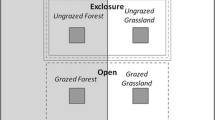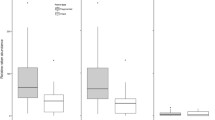Abstract
Uncontrolled cattle grazing is frequent in protected areas across the tropics but its effect on habitat structure and biodiversity is poorly known. We used generalized additive models to examine the precise relationships between cattle grazing intensity, vegetation structure, and raptor occurrence and richness across 39 1-km2 plots within the North West Biosphere Reserve, Peru. Cattle grazing was widespread and intensity was negatively correlated with average canopy height and percentage of vegetation cover at 5–15 m. Raptors were influenced by cattle density but they were probably more strongly influenced by canopy and sub-canopy characteristics. Raptor species responded differently to increasing cattle density: presence of species that hunted or searched for food in open habitats increased with cattle density, while presence of range restricted species that hunted from perches, and declining species decreased. Moderate cattle densities (20–60 cows km−2) may actually benefit some raptor species and help to maintain the high raptor diversity in the study area. Reserve authorities should, however, act to reduce cattle densities in some areas, which can exceed 120 cows km−2, that seriously affect some key raptor species, and cause forest to be converted to permanent cattle pasture.




Similar content being viewed by others
References
Aguirre ZR, Linares-Palomino R, Kvist L (2006) Woody species and vegetation formations in seasonally dry forests of Ecuador and Peru. Arnaldoa 13:324–350
Augustine DJ (2003) Long-term, livestock-mediated redistribution of nitrogen and phosphorus in an East African Savanna. J Appl Ecol 40:137–149
Barnes RFW (2001) How reliable are dung counts for estimating elephant numbers? Afr J Ecol 39:1–9
Best B, Kessler M (1995) Biodiversity and conservation in Tumbesian Ecuador and Peru. BirdLife International, Cambridge
BirdLife International (2012) Species factsheet: Leucopternis occidentalis. http://www.birdlife.org. Accessed 21 July 2012
Buckland ST, Marsden SJ, Green RE (2008) Estimating bird abundance: making methods work. Bird Conserv Int 18:91–108
Burnham KP, Anderson DR (2002) Model selection and multimodel inference: a practical information-theoretic approach. Springer, New York
Buschbacher RJ (1987) Cattle productivity and nutrient fluxes on an Amazon pasture. Biotropica 19:200–207
Cano PD, Leynaud GC (2010) Effects of fire and cattle grazing on amphibians and lizards in northeastern Argentina (Humid Chaco). Eur J Wildl Res 56:411–420
Cosyn E, Claerbout S, Lamoot I, Hoffmann M (2005) Endozoochorous seed dispersal by cattle and horse in a spatial heterogeneous landscape. Plant Ecol 178:149–162
de Haan C, Steinfeld H, Blackburn H (1997) Livestock and the environment: finding a balance. Food and Agriculture Organization of the United Nations, the United States Agency for International Development and the World Bank
Ervin J (2003) Protected area assessment in perspective. Bioscience 53:819–822
Fuller RJ (2001) Responses of woodland birds to increasing numbers of deer: a review of evidence and mechanisms. Forestry 74:289–298
Gillet F, Kohler F, Vandenberghe C, Buttler A (2010) Effect of dung deposition on small-scale patch structure and seasonal vegetation dynamics in mountain pastures. Agric Ecosyst Environ 135:34–41
Granadeiro JP, Andrade J, Palmeirim JM (2004) Modeling the distribution of shorebirds in estuarine areas using generalized additive models. J Sea Res 52:227–240
GRIN (2012). http://www.globalraptors.org/grin/SpeciesExtended.asp?specID=8091&catID=2007. Accessed 10 Sept 2012
Guerrero J (2002) Ecología del fuego en el Parque Nacional y Área Natural de Manejo Integrado Kaa-Iya del Gran Chaco, Santa Cruz. CABI/WCS, Bolivia, Santa Cruz
Guisan A, Edwards TC, Hastie T (2002) Generalized linear and generalized additive models in studies of species distributions: setting the scene. Ecol Model 157:89–100
Hastie T, Tibirishany R (1986) Generalized additive models. Stat Sci 1:297–318
Hirata M, Hasegawa N, Nomura M, Ito H, Nogami K, Kangoro N, Sonoda T (2009) Deposition and decomposition of cattle dung in forest grazing in southern Kyushu, Japan. Ecol Res 24:119–125
Johnson MD, Horn CH (2008) Effects of rotational grazing on rodents and raptors in a coastal grassland. West N Am Nat 68:444–452
Johnson JB, Omland KS (2004) Model selection in ecology and evolution. Trends Ecol Evol 19:101–108
Knopf FL, Sedgwick JA, Cannon RW (1988) Guild structure of a riparian avifauna relative to seasonal cattle grazing. J Wildl Manag 52:280–290
Kutt AS, Woinarski JC (2007) The effect of grazing and fire on vegetation and the vertebrate assemblage in a tropical savanna woodland in north-eastern Australia. J Trop Ecol 23:95–106
Leal-Pinedo JM, Linares-Palomino R (2005) Los bosques secos de la Reserva de Biosfera del Noroeste (Perú): diversidad arbórea y estado de conservación. Caldasia 27:195–211
Letnic M, Dickman CR, Tischler MK, Tamayo B, Beh CL (2004) The response of small mammals and lizards to post-fire succession and rainfall in arid Australia. J Arid Environ 59:85–114
Linares-Palomino R (2006) Phytogeography and floristics of seasonally dry tropical forests in Peru. In: Pennington RT, Lewis GP, Ratter JA (eds) Neotropical savannas and seasonally dry forests: plant diversity, biogeography and conservation. CRC Press, Florida, pp 257–279
Marion WR, Ryder RA (1975) Perch-site preferences of four diurnal raptors in northeast Colorado. Condor 77:350–352
Marques FFC, Buckland ST, Goffin D, Dixon CE, Borchers DL, Mayle BA, Peace AJ (2001) Estimating deer abundance from line transect surveys of dungs: Sika deer in southern Scotland. J Appl Ecol 38:349–363
McDowell RW (2006) Contaminant losses in overland flow from cattle, deer and sheep dung. Water Air Soil Pollut 174:211–222
Naughton-Treves L, Alvarez-Berrios N, Brandon K, Bruner A, Holland MB, Ponce C, Saenz M, Suarez L, Treves A (2006) Expanding protected areas and incorporating human resource use: a study of 15 forest parks in Peru and Ecuador. Sustain Sci Pract Policy 2:1–13
Nepstad D, Carvalho G, Barros AC, Alencar A, Capobianco JP, Bishop J, Moutinho P, Lefebvre P, Lopez-Silva U, Prins E (2001) Road paving, fire regime feedbacks, and the future of Amazon forests. For Ecol Manage 154:395–407
Nunez S, Zegarra J (2006) Estudio geoambiental de la Cuenca del Río Puyango-Tumbes. Boletín No. 32 serie C. Geodinámica e Ingeniería Geológica. Instituto Geológico Minero y Metalúrgico, Lima
Odgen JC (1974) The short-tailed Hawk in Florida I. Migration, habitat, hunting techniques and food habits. Auk 91:95–110
Palmer SFC, Truscott A-M (2003) Browsing by deer in naturally regenerating Scots pine (Pinus sylvestris L.) and its effects on sapling growth. For Ecol Manage 182:31–47
Parsons DAB, Shackleton CM, Scholes RJ (1997) Changes in herbaceous layer conditions under contrasting land use systems in the semi-arid lowveld, South Africa. J Arid Environ 37:319–329
Pedrana J, Isacch JP, Bo MS (2008) Habitat relationships of diurnal raptors at local and landscape scales in southern temperate grasslands of Argentina. Emu 108:301–310
Piana R, Marsden SJ (2012) Diversity, community structure and niche characteristics within a diurnal raptor assemblage of northwestern Peru. Condor 114:279–289
Piana R, Crespo S, Angulo F, Ormaeche E, Alzamora M (2010) Grey Hawk Buteo nitidus and Ornate hawk-Eagle Spizaetus ornatus in north-west Peru. Cotinga 32:106–108
Plumptre AJ (2000) Monitoring mammal populations with line transect techniques in African forests. J Appl Ecol 37:356–368
Plumptre AJ, Harris S (1995) Estimating the biomass of large mammalian herbivores in a tropical montane forest: a method of faecal counting that avoids assuming a “steady state” system. J Appl Ecol 32:111–120
Preston CR (1990) Distribution of raptor foraging in relation to prey biomass and habitat structure. Condor 92:107–112
R Developing Core Team (2012) Version 2.15.0 (2012-03-30). R Foundation for Statistical Computing
Read JL, Cunningham R (2010) Relative impacts of cattle grazing and feral animals on an Australian arid zone reptile and small mammal assemblage. Aust Ecol 35:314–324
Ridgely RS, Greenfield PJ (2001) The birds of Ecuador. Cornell University Press, New York
Rotenberry JT, Wiens JA (1980) Habitat structure, patchiness and avian communities in North American steppe vegetation: a multivariate analysis. Ecol 61:1228–1250
Roth RR (1976) Spatial heterogeneity and bird species diversity. Ecology 57:773–782
Saab VA, Petit DR (1992) Impact of pasture development on winter bird communities in Belize, Central America. Condor 94:66–71
Seifan M, Kadmon R (2006) Indirect effects of cattle grazing on shrub spatial pattern in a mediterranean scrub community. Basic Appl Ecol 7:496–506
SERNANP (2010) Lineamientos para el aprovechamiento sostenible de los pastizales en la Reserva Nacional de Tumbes. Ministerio del Ambiente, Tumbes
Smith GT, Arnold GW, Sarre S, Abensperg-Traun M, Steven DE (1996) The effect of habitat fragmentation and livestock grazing on animal communities in remnants of Gimlet Eucalyptus salubris in the Western Australia Wheatbelt. II. Lizards. J Appl Ecol 33:1302–1310
Stern M, Quesada M, Stoner KE (2002) Changes in composition and structure of a tropical dry forest following intermittent cattle grazing. Rev Biol Trop 50:1021–1034
Thiollay JM (1989) Censusing of diurnal raptors in a primary rain forest: comparative methods and species detectability. J Raptor Res 23:72–84
Thiollay JM (1993) Response of a raptor community to shrinking area and degradation of tropical rain forest in the south Western Ghats (India). Ecography 16:97–110
Thomas L, Buckland ST, Rexstad E, Laake JL, Strindberg S, Hedley SL, Bishop JRB, Marques T, Burnham K (2010) Distance software: design and analysis of distance sampling surveys for estimating population size. J Appl Ecol 47:5–14
Titus K, Mosher JA (1981) Nest-site habitat selected by woodland hawks in the central Appalachians. Auk 98:270–281
Torre I, Diaz M, Martinez-Padilla J, Bonal R, Vinuela J, Fargallo JA (2007) Cattle grazing, raptor abundance and small mammal communities in Mediterranean grasslands. Basic Appl Ecol 8:565–575
van de Koppel J, Rietkerk M, Weissing FJ (1997) Catastrophic vegetation shifts and soil degradation in terrestrial grazing systems. Trends Ecol Evol 12:352–356
Vargas H (1995) Food habits, breeding biology and status of the gray-backed Hawk (Leucopternis occidentalis) in western Ecuador. Dissertation, Boise State University
Vilchis LI, Balance LT, Fiedler PC (2006) Pelagic habitat of seabirds in the eastern tropical Pacific: effects of foraging ecology on habitat selection. Mar Ecol Prog Ser 315:279–292
Weeda WC (1967) The effect of cattle dung patches on pasture growth, botanical composition and pasture utilization. N Z J Agric Res 10:150–159
Wisz MS, Hijsmans RJ, Li J, Peterson AT, Graham CH, Guisan A et al (2008) Effects on sample size on the performance of species distribution models. Divers Distrib 14:763–773
Acknowledgments
This research was funded by The Peregrine Fund, Rufford Small Grants for Nature Conservation, the Association of Field Ornithologists, Cleveland Metroparks Zoo and Cleveland Zoological Society, and Idea Wild. We thank Virgilio and Wilson Rueda local guides from Pampas de Hospital for help in the field. The Instituto Nacional de Recursos Naturales (INRENA) and Ministry of the Environment granted permits to conduct field work.
Author information
Authors and Affiliations
Corresponding author
Electronic supplementary material
Below is the link to the electronic supplementary material.
Rights and permissions
About this article
Cite this article
Piana, R.P., Marsden, S.J. Impacts of cattle grazing on forest structure and raptor distribution within a neotropical protected area. Biodivers Conserv 23, 559–572 (2014). https://doi.org/10.1007/s10531-013-0616-z
Received:
Accepted:
Published:
Issue Date:
DOI: https://doi.org/10.1007/s10531-013-0616-z




